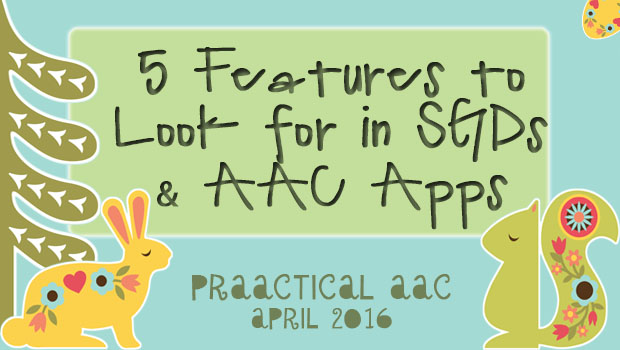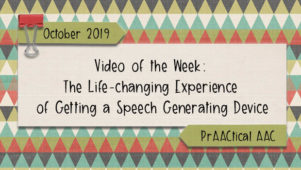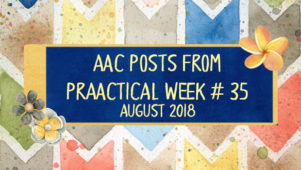5 Features to Look for in SGDs and AAC Apps

Isn’t it amazing how sophisticated some of the SGDs and AAC apps have become? We all realize the importance of looking at their features and making selections based on assessment information and data from trial periods. Beyond that, there are features that are important to us as interventionists. Here are some to look for as you explore AAC apps and traditional SGDs.
Data collection: The history feature is very helpful, but many high tech SGDs and AAC apps can be configured to gather additional data that we can use for a variety of purposes. Busy professionals appreciate this information and can use it in their assessments and goal-setting.
Data analysis: A few AAC software programs and apps even help us make sense of the data that is gathered. This allows us to adjust our therapy and support plans to better meet the needs of our clients.
Easy and reliable back-up: The value of this feature often waits for times of crisis to reveal itself. If you’ve even worked with clients who are adept at wiping things clean, or lost programmed page sets for another reason, you probably know what I’m talking about. Any high tech AAC tool needs to be backed up when programming changes are made and having systems that allow us to do this in a quick and reliable fashion makes our lives a lot easier.
Alphabet access: As a field, we are learning quite a lot about how to support the literacy development of people with AAC needs. Providing consistent access to the alphabet is something we didn’t used to do for all learners. Now, however, we understand the importance of this for people with a wide range of abilities.
Exploration: Language learning is a long and complex process. To expedite it, we need to give our AAC clients a means of exploring a larger set of words and word forms than what they can currently use in a functional and appropriate fashion. Several SGDs and AAC apps that have supportive features such as icon tutor and babble that can allow learners to explore, play, and experiment with language. These experiences, while slightly annoying or disruptive at times, are part of the language acquisition process that learners with typical development engage in. Doesn’t it make sense to encourage this in AAC learners as well?
Do you have favorite features that you look for in SGDs and AAC apps? We’d love to hear about them.
Filed under: Featured Posts, PrAACtical Thinking
Tagged With: AAC app, feature match, SGD, the fives
This post was written by Carole Zangari





7 Comments
This would be way more helpful if you listed the Apps/SGDs that have these features!
I’d add the ability to hide/unhide buttons without moving the other buttons around.
Ettina, I’m right there with you! Thanks for taking the time to add that great feature.
I would love to know some that you recommend. It’s very time consuming to look for great apps. I would love a post about apps you recommend.
How about the ability to type a word to find its location in the page set? Even better when the feature then walks you through the button sequence to say it.
Hello,
I was wondering if you can help me find out how I can get something like this for my daughter? I would be very grateful. Have a wonderful holiday!
Sincerely, Lisa Weldon
Lisa, not sure where you are located but in the US the process starts with an AAC evaluation led by a speech-language pathologist. Public school students can get this through the schools at no charge, but you can also seek outside services at your own expense, through health insurance, etc. The AAC evaluation should include information gathering (from family, aides, teachers), direct assessment (formal and/or informal testing), and a series of trials to test out each of the top options in a functional setting. Hope that helps. 🙂 Happy holidays to you, too!